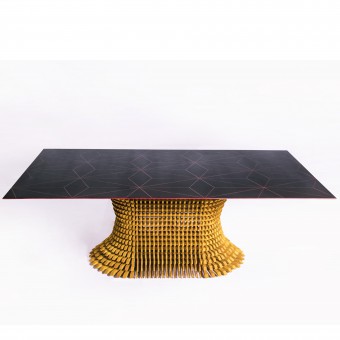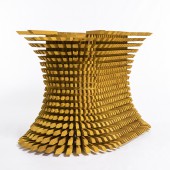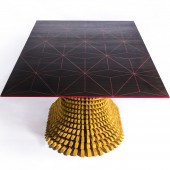NUi Deus ex Machina Table by Jaime Rosales |
Home > |
 |
|
||||
| DESIGN DETAILS | |||||
| DESIGN NAME: NUi Deus ex Machina PRIMARY FUNCTION: Table INSPIRATION: Our design is the progression from last year’s bookcase, that shows that innovation is the only way, to find lasting solutions to enduring problems. Inspired by the belief that any piece of wood, irrespective of size, has a uniqueness that beckons to be revealed. Hence, the use of small pieces that, in their own distinctiveness, elevate the whole. The goal was to find a solution that enabled a product, as ubiquitous as a table, to be enhanced in structure and aesthetics by virtue of its assembly. UNIQUE PROPERTIES / PROJECT DESCRIPTION: This unique table is a celebration of wood, as much as an affirmation that much can be done with very little. It speaks to the significance of shorts, those dimensions that are often not used to their full potential. It is also an aspirational idea seeking to shift the paradigm of how best to harness and use this life giving resource. Through this new assembly system, small pieces can be configured into alluring forms; converting shorts into a fluid base and an ultra light top that redefine what is possible. OPERATION / FLOW / INTERACTION: This design is only possible through the use of a newly developed interlocking system. At each joint, a plastic connector exerts strong approximation forces that mechanically bind two wood pieces together. Each link effectively shifts the structural burden from the wood to the connector, thus reducing the wood volumes that are normally required. Moreover, these connections are far superior to any traditional wood joint from a; practical, functional and structural standpoint. One of the many advantages is that by disengaging the connectors, any design, can be assembled, disassembled with great ease and if needed, reconfigured dimensionally. PROJECT DURATION AND LOCATION: Every phase of the development process from: conceptual design, structural analysis and viability, prototyping, woodworking, to final finishing and assembly, was carried at our design studio on the outskirts of Managua, Nicaragua. The design concept was develop over the course of 2 months and the project was officially launched on November, 11th, 2017 and was completed on Feb 21st, 2018. FITS BEST INTO CATEGORY: Furniture Design |
PRODUCTION / REALIZATION TECHNOLOGY: Our passion for 3D design softwares, allowed each and every component to be meticulously modeled and configured for precise fit and function. All of the design components were handcrafted, from solid hardwood elements, mindful that their rough dimensions ensured optimal use of this precious resource. Once all the wood components were crafted, to exacting tolerances, they were stained with natural pigments and the top was finished with a triple layer of polyurethane coating. Then the top received the geometric pattern, using CNC technology and the resulting lines were stained with an organic magenta pigment and recoated. Ultimately, the interconnecting elements allowed; 1548 base parts, as well as the 22 that comprised the tabletop, to be linked to one another and in so doing, becoming an integral part of the structural framework. SPECIFICATIONS / TECHNICAL PROPERTIES: Table top: 1900 mm x 22000 mm Thickness: 23 mm Base: 790 mm x 1300 mm x 725 mm Hardwood Species: Carapa guianensis Commercial Name: Andiroba TAGS: Table, Dinner Table, Dining Table, Wood Table, Modern Table, Solid Wood Table, Hardwood Table, Solid Hardwood Table, Flat Pack, Organic Design, Eco-Friendly Wood Furniture, Wood Design, Innovation, Natural Pigment, Wood-Specific Interlocking Assembly System, Tool-less Wood Construction, DIY Design, Interconnection System for Wood, Tool-less Assembly & Disassembly, Modular Woodworking RESEARCH ABSTRACT: Wood processing is, to a large extent, a technology stricken industry. That is to say, that the methods used to add value have, essentially, remained unchanged. The urgency to innovate is all the more pressing due to the looming environmental changes attributed, in part, to global deforestation. This reality, particularly for third world countries, is derived from the dismal milling yields that range from 30% to 40%. Arguably, these low yields relate to the way that lumber has been historically commercialized and processed. In order to maximize commercial value, lumber dimensions have been standardized to incentivize greater widths and lengths. So the research focused on the impact that a wood specific assembly system would have on the overall wood yield from tree to finished product. Specifically, the focus was on, quantitively and qualitatively, assessing the key factors that could markedly upend the current constraints. Clearly, the overriding need is to invent new assembly solutions to harness and add value to the “shorts” or fallout, generated by current milling practices. The purpose of this design, was to exemplify the attributes and possibilities of harnessing shorts. Due to the structural proficiency of the connections, wood can finally be used in thickness that are, generally, associated with inert materials such as glass and plastics. It follows that, by using this system, wood requirements are drastically reduced as compared to conventional joining techniques. CHALLENGE: The challenge was to reimagine a entirely new way to link wood, through the use of mechanical interlocking connectors. In this day and age, its mind boggling that; screws, nails, glues and joinery is all there really is to work with wood. Hence, this ultra light, dining table for 8, redefines traditional assembly by leveraging the entirety of it's 1570 short, wood pieces to act as the aesthetic and structural matrix. So the entire design, is linked by connectors that, collectively, make up the structural integrity. Arguably, it is the ultimate use of this finite resource as well as a compelling expression of sustainability. ADDED DATE: 2018-02-28 22:01:42 TEAM MEMBERS (8) : Principal Designer: Jaime Rosales, 3D Designer & Creative Director: Mario Mendieta, Designer & Lead Craftsman: Guillermo Martínez, Master Craftsman: Luis Acuña, Master Craftsman: Federico Medina , Finishing Artist: Wilbert Hernández, Sanding Artist: Alejandro Guzmán and IMAGE CREDITS: Glenda Martínez Fotografía |
||||
| Visit the following page to learn more: http://www.nui.one | |||||
| AWARD DETAILS | |
 |
Nui Deus Ex MacHina Table by Jaime Rosales is Runner-up for A' Design Award in Furniture Design Category, 2017 - 2018.· Press Members: Login or Register to request an exclusive interview with Jaime Rosales . · Click here to register inorder to view the profile and other works by Jaime Rosales . |
| SOCIAL |
| + Add to Likes / Favorites | Send to My Email | Comment | Testimonials |







